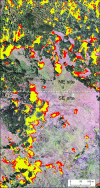Invasion of dwarf bamboo into alpine snow-meadows in northern Japan: pattern of expansion and impact on species diversity
- PMID: 22393485
- PMCID: PMC3287379
- DOI: 10.1002/ece3.9
Invasion of dwarf bamboo into alpine snow-meadows in northern Japan: pattern of expansion and impact on species diversity
Abstract
Recently, a dwarf bamboo species,Sasa kurilensis; Poaceae, has invaded into alpine snow-meadows in the wilderness area of the Taisetsu Mountains, northern Japan. This dwarf bamboo species has a wide distribution range from lowland to alpine sites of snowy regions. Because of the formation of dense evergreen culms and an extensive rhizome system, other plants are excluded following invasion by this dwarf bamboo, resulting in low species diversity. Dwarf bamboo originally inhabited the leeward slopes of alpine dwarf pine (Pinus pumila) clumps in alpine regions. During the last 32 years, however, dwarf bamboo has expanded its distribution area by up to 47% toward snow-meadows, especially on southeastern facing slopes. This rapid change may be related to the decrease in soil moisture and expansion of the annual growing period caused by the recent acceleration of snowmelt time. A multiyear census revealed that the density of bamboo culms increased 30-150% during 2 years, and the annual expansion of bamboo rhizomes was 39 cm on average. In addition to the expansion of bamboo clumps by vegetative growth, the possibility of migration by seed dispersal was also suggested by a genet analysis. With the increase in culm density, the species richness of snow-meadow vegetation decreased to less than one-quarter of the original level due to intense shading by dwarf bamboo. The rapid vegetation change in these almost pristine alpine environments isolated from the human activity implies that global climate change already influences the alpine ecosystem.
Keywords: Alpine vegetation; Sasa kurilensis; global warming; remote sensing; snowmelt; soil moisture.
Figures






Similar articles
-
Clonal structure, seed set, and self-pollination rate in mass-flowering bamboo species during off-year flowering events.PLoS One. 2014 Aug 12;9(8):e105051. doi: 10.1371/journal.pone.0105051. eCollection 2014. PLoS One. 2014. PMID: 25115953 Free PMC article.
-
Development of microsatellite markers for the dwarf bamboo species Sasa cernua and Sasa kurilensis (Poaceae) in northern Japan.Mol Ecol Resour. 2009 Nov;9(6):1470-2. doi: 10.1111/j.1755-0998.2009.02675.x. Epub 2009 Apr 12. Mol Ecol Resour. 2009. PMID: 21564935
-
Timing of forest fine root production advances with reduced snow cover in northern Japan: implications for climate-induced change in understory and overstory competition.Oecologia. 2021 May;196(1):263-273. doi: 10.1007/s00442-021-04914-x. Epub 2021 Apr 23. Oecologia. 2021. PMID: 33891170
-
Himalayan alpine ecohydrology: An urgent scientific concern in a changing climate.Ambio. 2023 Feb;52(2):390-410. doi: 10.1007/s13280-022-01792-2. Epub 2022 Nov 2. Ambio. 2023. PMID: 36324019 Free PMC article. Review.
-
[Vegetation and soil characteristics of degraded alpine meadows on the Qinghai-Tibet Pla-teau, China: A review].Ying Yong Sheng Tai Xue Bao. 2020 Jun;31(6):2109-2118. doi: 10.13287/j.1001-9332.202006.002. Ying Yong Sheng Tai Xue Bao. 2020. PMID: 34494765 Review. Chinese.
Cited by
-
The global distribution of bamboos: assessing correlates of introduction and invasion.AoB Plants. 2017 Jan;9(1):plw078. doi: 10.1093/aobpla/plw078. Epub 2016 Dec 23. AoB Plants. 2017. PMID: 28013249 Free PMC article.
-
Multivariate path analysis of the relationships between seedling regeneration and environmental factors beneath a dwarf bamboo understory.Ecol Evol. 2019 Sep 3;9(18):10277-10290. doi: 10.1002/ece3.5548. eCollection 2019 Sep. Ecol Evol. 2019. PMID: 31624551 Free PMC article.
-
The Impact of Phenological Gaps on Leaf Characteristics and Foliage Dynamics of an Understory Dwarf Bamboo, Sasa kurilensis.Plants (Basel). 2024 Mar 4;13(5):719. doi: 10.3390/plants13050719. Plants (Basel). 2024. PMID: 38475565 Free PMC article.
-
Lags in the response of mountain plant communities to climate change.Glob Chang Biol. 2018 Feb;24(2):563-579. doi: 10.1111/gcb.13976. Epub 2017 Nov 27. Glob Chang Biol. 2018. PMID: 29112781 Free PMC article. Review.
-
Accessing the impacts of bamboo expansion on NPP and N cycling in evergreen broadleaved forest in subtropical China.Sci Rep. 2017 Jan 9;7:40383. doi: 10.1038/srep40383. Sci Rep. 2017. PMID: 28067336 Free PMC article.
References
-
- Arft AM, Walker MD, Gurevitch J, Alatalo JM, Bret-Harte MS, Dale M, Diemer M, Gugerli F, Henry GHR, Jones MH, et al. Responses of tundra plants to experimental warming: meta-analysis of the International Tundra Experiment. Ecol. Monograph. 1999;69:491–511.
-
- Billings WD. Adaptations and origins of alpine plants. Arct. Alp. Res. 1974;6:129–142.
-
- Bokhorst SF, Bjerke JW, Tømmervik H, Callaghan TV, Phoenix GK. Winter warming events damage sub-Arctic vegetation: consistent evidence from an experimental manipulation and a natural event. J. Ecol. 2009;97:1408–1415.
-
- Bret-Harte SM, Shaver GR, Zoerner JP, Johnstone JF, Wagner JL, Chavez AS, Gunkelman RF, IV, Lippert SC, Laundre JA. Developmental plasticity allowsBetula nanato dominate tundra subjected to an altered environment. Ecology. 2001;82:18–32.
-
- Callaway RM, Brooker RW, Choler P, Kikvidze Z, Lortie CJ, Michalet R, Paolini L, Pugnaire FI, Newingham B, Aschehoug ET, et al. Positive interactions among alpine plants increase with stress. Nature. 2002;417:844–848. - PubMed
LinkOut - more resources
Full Text Sources

